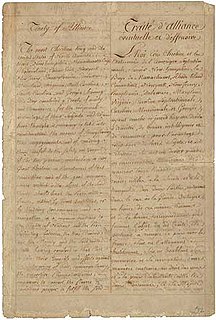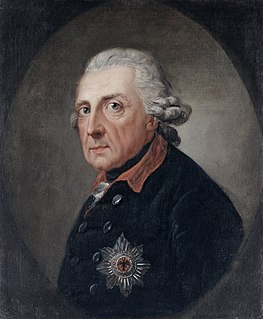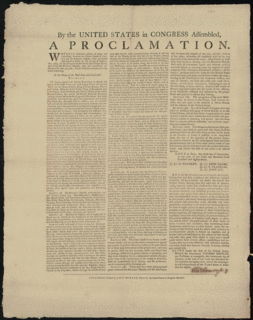 W
WThe Treaty of Alliance or Franco-American Treaty was a defensive alliance between France and the United States of America, formed in the midst of the American Revolutionary War, which promised mutual military support in case fighting should break out between French and British forces, as the result of signing the previously concluded Treaty of Amity and Commerce. The alliance was planned to endure indefinitely into the future. Delegates of King Louis XVI of France and the Second Continental Congress, who represented the United States at this time, signed the two treaties along with a separate and secret clause dealing with future Spanish involvement, at the hôtel de Coislin in Paris on February 6, 1778. The Franco-American alliance would technically remain in effect until the 1800 Treaty of Mortefontaine, despite being annulled by the United States Congress in 1793 when George Washington gave his Neutrality Proclamation speech saying that America would stay neutral in the French Revolution.
 W
WThe Treaty of Amity and Commerce Between the United States and France, was the first of two treaties between the United States and France, signed on February 6, 1778, at the Hôtel de Coislin in Paris. Its sister treaty, the Treaty of Alliance were signed immediately thereafter. The Treaty of Amity and Commerce recognized the de facto independence of the United States and established a strictly commercial treaty between the two nations as an alternative to, and in direct defiance of, the British Acts of Trade and Navigation; the Treaty of Alliance, for mutual defense, was then signed "particularly in case Great Britain in Resentment of that connection and of the good correspondence which is the object of the [first] Treaty, should break the Peace with France, either by direct hostilities, or by hindering her commerce and navigation, in a manner contrary to the Rights of Nations, and the Peace subsisting between the two Crowns". These were the first treaties ever negotiated by the fledgling United States and signed in the midst of the American Revolutionary War. Due to later complications with the alliance treaty, America would not sign another military alliance until the Declaration by United Nations in 1942.
 W
WThe Treaty of Amity and Commerce between the Kingdom of Prussia and the United States of America was a treaty negotiated by Count Karl-Wilhelm Finck von Finckenstein, Prussian Prime Minister, and Thomas Jefferson, United States Ambassador to France, and signed by Frederick the Great and George Washington. The treaty established a commercial alliance between the Kingdom of Prussia and the United States of America and was the first one signed by a European power with the United States after the American Revolutionary War. The Kingdom of Prussia became therefore one of the first nations to officially recognize the young American Republic after the Revolution. The first nation to recognize the US was Sweden, who during the Revolution signed a Treaty of Amity and Commerce.
 W
WThe Articles of Confederation and Perpetual Union was an agreement among the 13 original states of the United States of America that served as its first constitution. It was approved, after much debate, by the Second Continental Congress on November 15, 1777, and sent to the states for ratification. The Articles of Confederation came into force on March 1, 1781, after being ratified by all 13 states. A guiding principle of the Articles was to preserve the independence and sovereignty of the states. The weak central government established by the Articles received only those powers which the former colonies had recognized as belonging to king and parliament.
 W
WThe Bank of North America was a private national bank which served as the United States' first de facto central bank. Chartered by the Continental Congress on May 26, 1781, and opened in Philadelphia on January 7, 1782, it was based upon a plan presented by US Superintendent of Finance Robert Morris on May 17, 1781, based on recommendations by Revolutionary era figure Alexander Hamilton. Failing to gain and maintain sufficient long term traction in that role, it was succeeded by the also privately held First Bank of the United States in 1791.
 W
WThe Flag Acts are three laws that sought to define the design of the flag of the United States. All the submitted suggestions were remarkably short, the shortest being a sentence of 31 words, and the longest being a title and two sentences of 117 words.
 W
WThe Treaty of Fort Pitt, also known as the Treaty With the Delawares, the Delaware Treaty, or the Fourth Treaty of Pittsburgh, was signed on September 17, 1778, and was the first written treaty between the new United States of America and any American Indians, in this case the Lenape. Although many informal treaties were held with Native Americans during the American Revolution from 1775 to 1783, the only one that resulted in a formal document was signed at Fort Pitt, Pennsylvania, now the site of Downtown Pittsburgh. It was essentially a formal treaty of alliance.
 W
WThe Treaty of Fort Stanwix was a treaty finalized on October 22, 1784, between the United States and Native Americans from the six nations of the Iroquois League. It was signed at Fort Stanwix, in present-day Rome, New York, and was the first of several treaties between Native Americans and the United States after the American victory in the Revolutionary War.
 W
WThe Great Seal is a principal national symbol of the United States. The phrase is used both for the physical seal itself, which is kept by the United States Secretary of State, and more generally for the design impressed upon it. The obverse of the Great Seal depicts the national coat of arms of the United States.
 W
WThe Land Ordinance of 1785 was adopted by the United States Congress of the Confederation on May 20, 1785. It set up a standardized system whereby settlers could purchase title to farmland in the undeveloped west. Congress at the time did not have the power to raise revenue by direct taxation, so land sales provided an important revenue stream. The Ordinance set up a survey system that eventually covered over 3/4 of the area of the continental United States.
 W
WIn December 1777, the Moroccan Sultan Muhammad III included the United States in a list of countries to which Morocco’s ports were open. Morocco thus became the first country whose head of state publicly recognized the newly independent United States. Relations were formalized with the Moroccan–American Treaty of Friendship (also known as the Treaty of Marrakesh) negotiated by Thomas Barclay in Marrakesh, and signed by American diplomats in Europe, Thomas Jefferson, John Adams with Sultan Muhammad III in 1786.
 W
WThe Northwest Ordinance enacted July 13, 1787, was an organic act of the Congress of the Confederation of the United States. It created the Northwest Territory, the new nation's first organized incorporated territory, from lands beyond the Appalachian Mountains, between British North America and the Great Lakes to the north and the Ohio River to the south. The upper Mississippi River formed the territory's western boundary. Pennsylvania was the eastern boundary.
 W
WThe Petition to the King was a petition sent to King George III by the First Continental Congress in 1774, calling for repeal of the Intolerable Acts.
 W
WRatification Day in the United States is the anniversary of the congressional proclamation of the ratification of the Treaty of Paris, begun a year after on January 14, 1784, at the Maryland State House in Annapolis, Maryland by the Confederation Congress.
 W
WThe Treaty of Watertown, the first foreign treaty concluded by the United States of America after the adoption of the Declaration of Independence, was signed on July 19, 1776, in the Edmund Fowle House in the town of Watertown, Massachusetts Bay. The treaty established a military alliance between the United States and the St. John's and some of the Mi'kmaw bands against Great Britain for the early years of the American Revolutionary War.